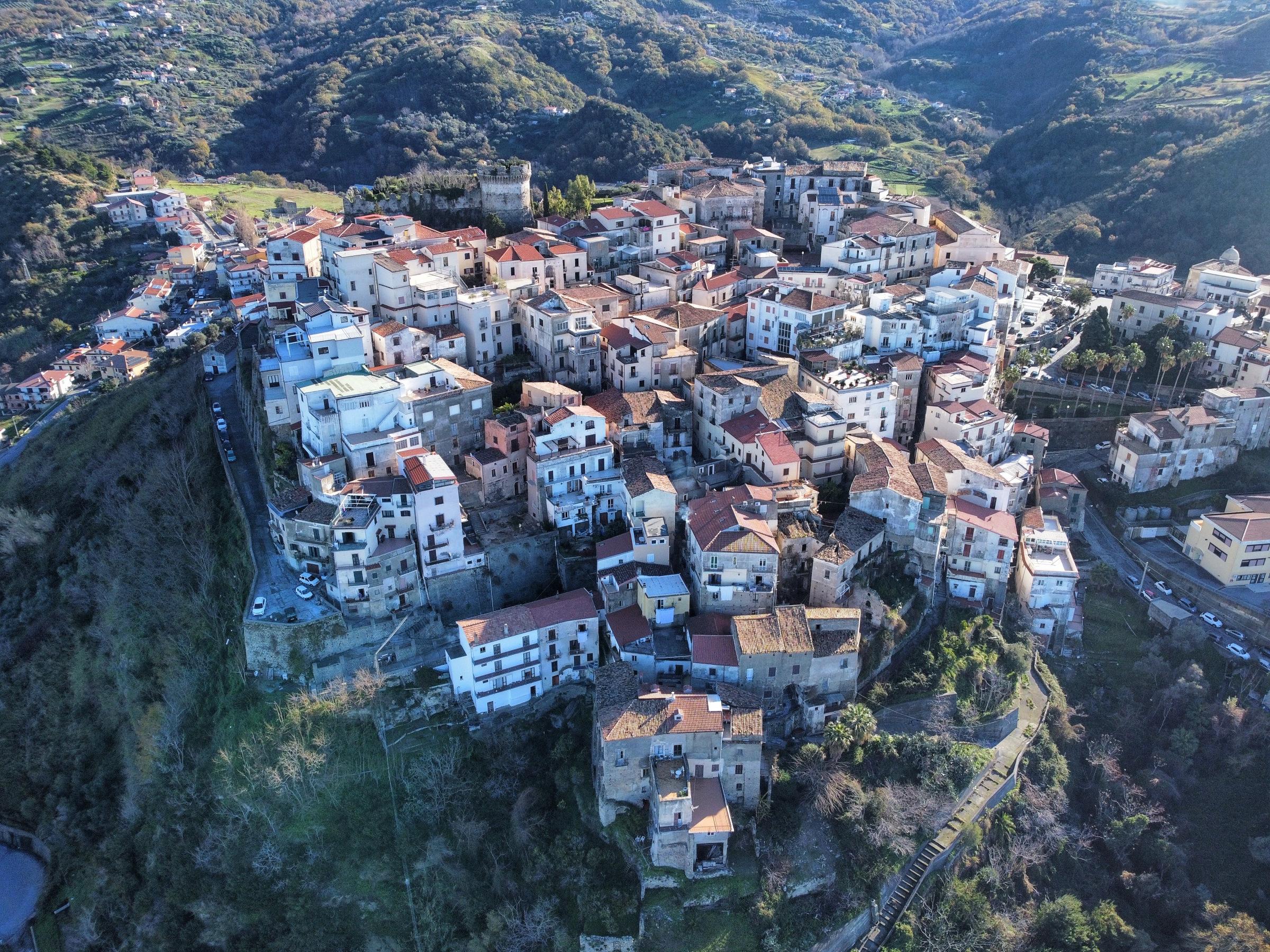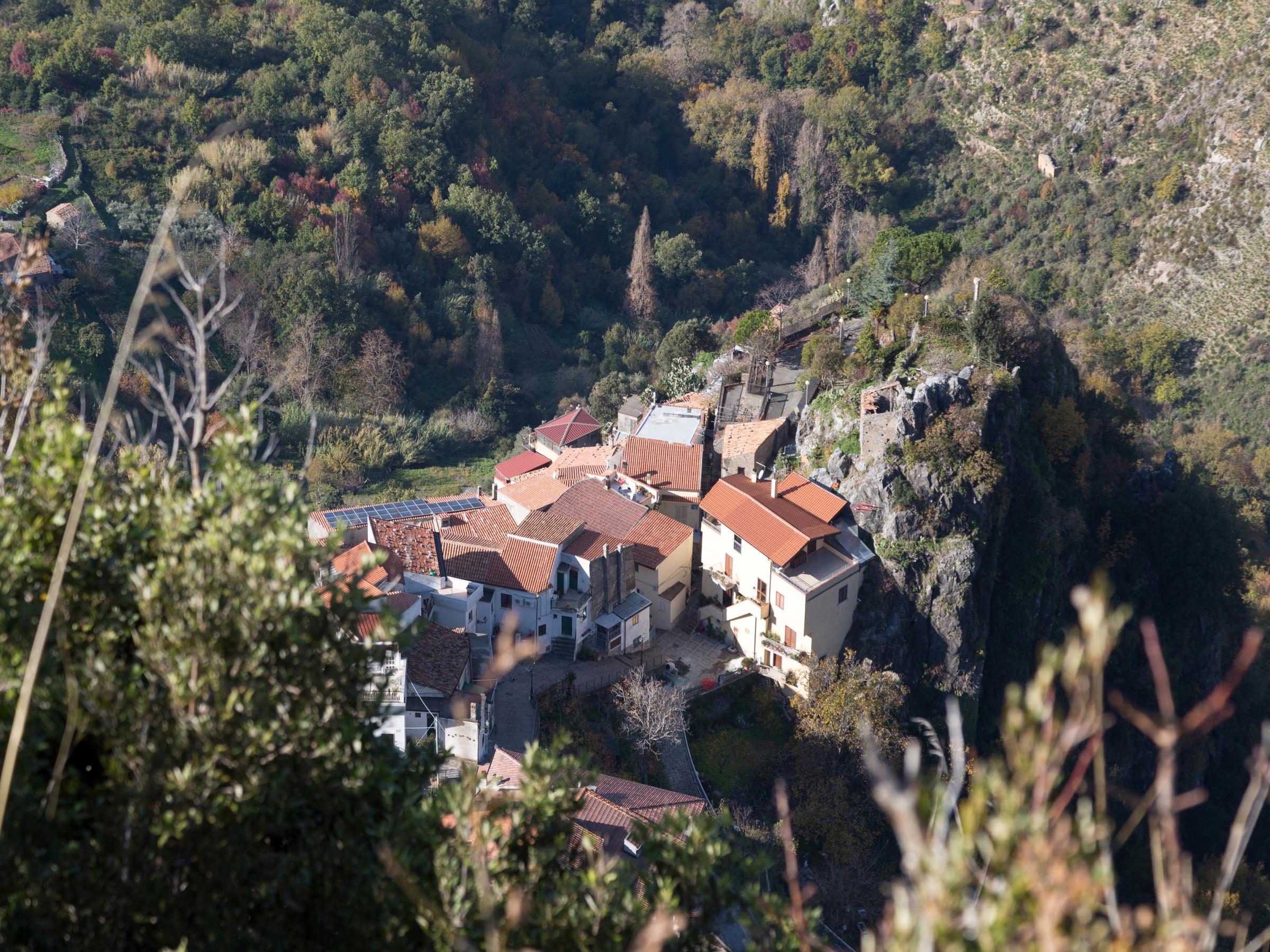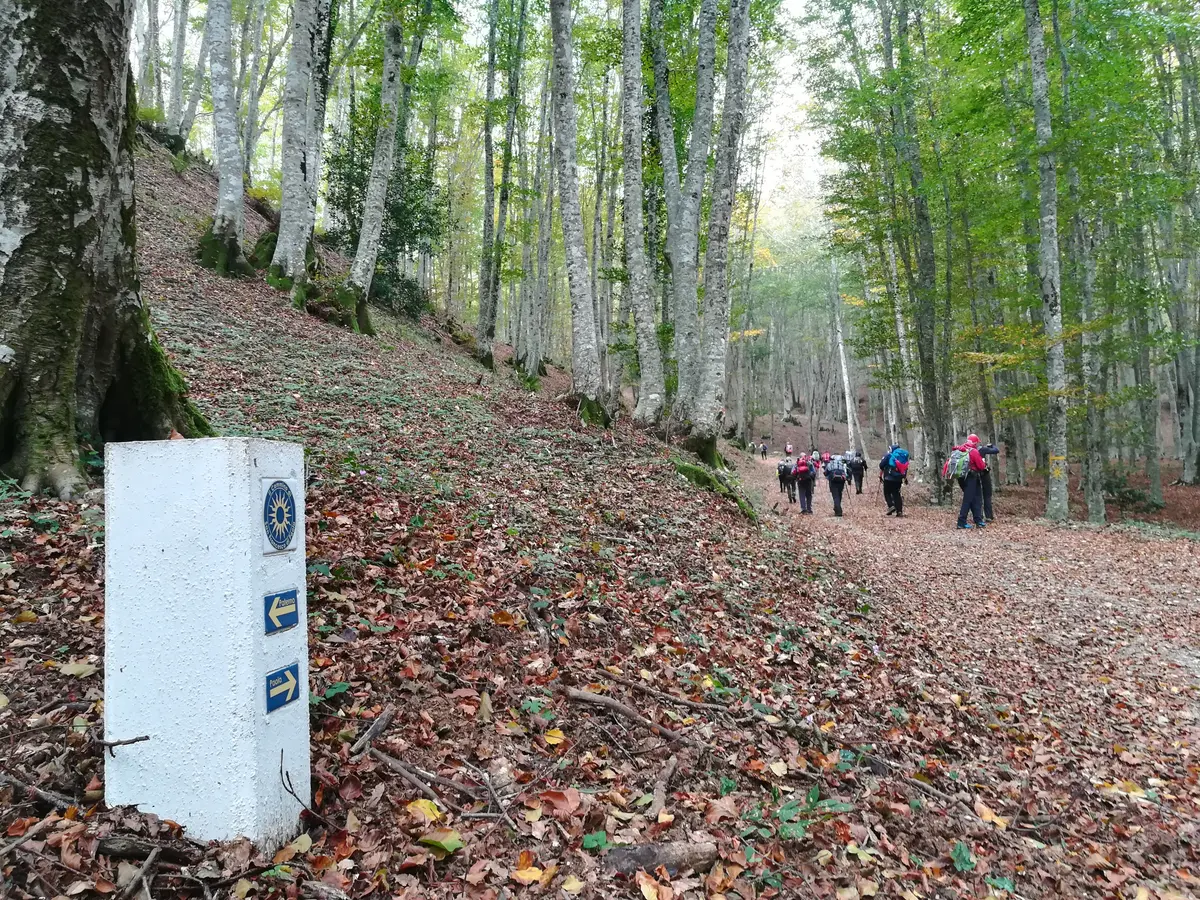Itinerary through the villages of Pollino
Folklore, nature and delicious food in the Pollino National Park

Naturalistic
Papasidero - Luca Fregola
Travel information
Category
Naturalistic
Target
For all
A tour of the villages of Pollino is just the thing if you love excursions that combine some of Italy's Most Beautiful Villages with local traditions and mountain landscapes. Scattered throughout the province of Cosenza, in the green territory of the Pollino National Park, these villages offer an authentic glimpse of Calabrian life, from the flavours and typical cuisine, with renowned "Slow Food Presidia", the customs and traditions of the Arbëreshë (Italo-Albanian) ethnolinguistic communities and endless opportunities for outdoor sports in all seasons of the year: from rafting to hiking and horse riding. Ready to set off on a unique journey to discover the main villages of Pollino?

Art, history and oil tastings
The itinerary through the villages of Pollino starts on the eastern side of the province of Cosenza, discovering Oriolo, one of Italy's Most Beautiful Villages with breathtaking views. The Castle is the symbol of the medieval village and is one of the finest Frederick castles in Calabria, hosting events and exhibitions. Inside, you can admire wonderful rooms: the Banquet Hall, the Audience Chamber, the Hall of Flags and the precious Bedroom of Margherita Pignone del Carretto, with its dome frescoed with a Triumph of Apollo.
Opposite the castle stands the Mother Church of San Giorgio Martire, of Norman origin, which houses the relics of St. George and St. Francis of Paola. Among the villages of Pollino, Oriolo boasts a number of interesting museums: the MUDAM - Diffuse Museum of Arts and Crafts, the Museum of Rural Life in the 18th-century Palazzo Giannettasio, the Civic Museum - 'Casa della Cultura', the Municipal Art Gallery, the Porta San Giacomo Gallery, the House of Arts and Ideas and the Library Centre in Palazzo Tarsia-Toscano. Gourmets can sample three products with the De.Co. (Municipal Designation of Origin) label: Suckling Goat, Fennel Taralli and the prized Extra Virgin Olive Oil.

From Prehistory to the Middle Ages
The charm of San Lorenzo Bellizzi makes it one of the Pollino villages that is definitely worth visiting: in a breathtaking location, among the valleys that open onto the "Raganello Gorge" Nature Reserve, it is the perfect destination for a day trip. The small village of San Lorenzo Bellizzi seems suspended in time and reminds everyone of its prehistoric origins, dating back to the Neolithic period, as evidenced by the archaeological remains of the burial site found in the Sant'Angelo Stone Cave (7000 years ago), one of the most evocative places to visit. The name, San Lorenzo Bellizzi, is directly linked to a baronial family in the area, who built the first Chapel of San Lorenzo in devotion to the local saint. Subsequently, the government passed to the Marquises Pignatelli (1534). The village still bears traces of the noble families who ruled it throughout history.

The "City of Bread"
One of the villages in the Pollino area that epitomises local traditions is Cerchiara di Calabria, perched on the slopes of Mount Sellaro and dominated by the ruins of a Medieval Castle. Listed among the "Bread Cities" and "Slow Food Presidium", Cerchiara di Calabria dedicates a special festival to bread-making and has a Bread Museum, rich in tools and reconstructions of peasant life. Among the villages of Pollino, Cerchiara is famous for the important Shrine of the Madonna delle Armi, one of the most venerated Marian sites in the region: an ancient Byzantine female hermitage, the current building dates back to the 15th century, when it was dedicated to the Madonna delle Armi following a miraculous discovery. Also worth visiting is the Church of San Pietro, with its valuable paintings. Those who enjoy trekking among the villages of Pollino can take a trip to the Cessuta Park, the Acqua Rossa Wood and the legendary Cerchiara Caves, one of the best places for climbing, particularly in the Cave of the Nymphs: a cave from which sulphurous thermal waters flow.

In the heart of Arbëria
In the heart of the Pollino National Park, Frascineto represents the Arbëreshë (Italo-Albanian) communities that make up a large part of the villages in the Pollino area. This can be seen in the unmistakable urban layout in the form of gjitonìe: typical Albanian neighbourhoods made up of small houses arranged in a semicircle, overlooking a small communal square. Among the places not to be missed in Frascineto are the Baroque-style Parish Church of Santa Maria Assunta, with its characteristic bell tower and majestic dome; the 10th-century Byzantine-style Basilica Church of St. Peter and Paul; and the Chapel of the Madonna delle Armi (or Madonna di Lassù), carved into the rock of Timpone del Corvo. The two Albanian museums are also not to be missed: the Museum of Traditional Albanian Costumes and the Museum of Byzantine Icons. Wine lovers should not miss a visit to the "Vini del Pollino" Wine Cellar.

The "Capital of Pollino"
If there is one village in Pollino that has become the true "Capital of Pollino" throughout history, it is Castrovillari. The oldest part of the historic centre, known as the "Cìvita", represents the socio-political heart of the area. Dominated by the Aragonese Castle, which defended the Coscile Valley, this ancient district preserves some of the city's most beautiful monumental buildings, starting with the Franciscan Protoconvent (1220), now home to the SiMuCCà - Castrovillari Museum System (which includes the Archaeological Museum and the Sybaris Theatre, home to the "Primavera dei Teatri" Festival, one of the most important theatre festivals in the region). The walk ends with a visit to the Church of San Giuseppe (16th century), inside which you can admire a fresco of the Madonna of Constantinople (16th century) and two important paintings. Castrovillari is also known as the "City of Carnival", an event that combines entertainment and folklore.

The "Pollino Nativity Scene"
Morano Calabro is not only one of the most beautiful villages in Pollino, but also one of The Most Beautiful Villages in Italy! It is no coincidence that it is known as the 'Nativity Scene of Pollino' due to the characteristics of its traditional dress and its famous living nativity scene. Among the villages of Pollino, Morano Calabro is characterised by the ruins of its Castle, red roofs and medieval town centre with narrow streets, small squares and arcades leading down to the San Nicola district. The yellow and blue colours of the majolica dome and bell tower of the Collegiate Church of Santa Maria Maddalena are unmistakable. Inside, you can admire a Madonna degli Angeli by Antonello Gagini (1505). Don't miss the Museum of Agricultural and Pastoral History and the Pollino Naturalistic Study Centre 'Il Nibbio'. In spring, flower and fragrance lovers should visit the Campotenese Lavender Park and discover why the entire area is known as the Provence of Calabria.

A taste of Moscato wine
Halfway through our journey through the villages of Pollino, we stop for a tasting in Saracena, home of the delicious Moscato di Saracena, a Slow Food Presidium: a sweet wine produced from native Moscato grapes, with the addition of Malvasia and Guarnaccia, ideal for accompanying desserts at the end of a meal. Among the villages of Pollino, Saracena is a perfect example of Arab-Turkish urban planning in Calabria: as its name suggests, the village was besieged around 900 by Saracen pirates and liberated by the army of Constantinople, led, according to legend, by a woman wrapped in a sheet. The episode is depicted in the Chapel of St. Anthony of Padua and in the sacristy of the Church of S. Maria del Gamio. Don't miss a visit to the Andrea Alfano Municipal Art Gallery, inside Palazzo Mastromarchi (with 250 works from the 20th century, both Italian and international), and the Museum of Sacred Art, with a collection of paintings, furnishings and liturgical vestments, reliquaries and archival documents. Nature lovers can explore the Cave of St. Michael the Archangel, inhabited in prehistoric times, and stop at Lake Tavolara.

A "slow" village, among the most beautiful in Italy
Fancy a slow trip to one of the villages in the Pollino area, which is also one of Italy's Most Beautiful Villages? Just head to Altomonte, the "City of Bread" and "Slow City"! A picture-postcard village immersed in a medieval atmosphere, marked by the presence of the Norman Castle (12th century) and the buildings around the main square: the Church of Santa Maria della Consolazione, one of the finest examples of Calabrian Gothic-Angevin art, and the Dominican Convent, now home to the Library and Civic Museum. Other places to visit are the Azzinari Art Gallery Museum, inside the Pallotta Tower, and the Belluscio Theatre. The ideal time to visit Altomonte is during the period when the "Bread Festival" takes place. Among the villages of Pollino, Altomonte offers the tranquillity of the Farneto Park, with a small lake and a picnic area at its centre.

The castle overlooking the sea
The Pollino National Park is not just mountains! Among the villages of Pollino that overlook the sea, specifically the "Riviera dei Cedri" Regional Marine Park, Sangineto is an unmissable gem. The historic centre, with its typical medieval layout, is one of the most characteristic examples of the proximity of the sea and mountains in Calabria: a link between Sangineto Lido and the first foothills of Pollino. The panoramic stairways of the centre lead to the monumental Prince's Castle, built in the 14th century and now part of the "Historic Houses" circuit in Calabria: a quadrangular building with four cylindrical towers at the corners and a 16th-century loggia. Other buildings worth visiting in Sangineto are the Mother Church of S. Maria della Neve and the remains of the Convent of San Francesco di Paola (1558). Mountain lovers can reach Lake Penna, of great speleological interest, and the spectacular Vuglio Waterfall (u Gùgliu), accessible via the Path of Dreams.

The terrace overlooking the Tyrrhenian Sea
Let's stay on the Tyrrhenian coast to discover the beauty of Belvedere Marittimo, another of the Pollino villages suspended between the sea and the mountains. Belvedere also overlooks the "Riviera dei Cedri" Regional Marine Park and is famous for its panoramic Castle, a Norman stronghold associated with two watchtowers: Paolo Emilio Tower and Santa Litterata Tower. Among the villages of Pollino, Belvedere is known as the "City of Love" because the Capuchin Convent has kept the blood and bone fragments of St. Valentine, patron saint of lovers, for over 300 years. Those who choose Belvedere Marittimo for their summer holidays can enjoy not only the beaches, which offer all kinds of services for families, friends and couples, but also venture along the north coast to discover marine terraces, yellow sands and clayey ravines.

The paths of Art and Taste
One of Italy's Most Beautiful Villages, Buonvicino is a place of "good neighbourliness", as its name suggests, and above all of good food! Nestled at the foot of Mount Orsomarso, it consists of 19 districts scattered throughout the valley. The first of the Pollino villages to apply the tourist formula of the so-called diffuse hotel, under the name "Borgo dei Greci" (from the locality of Sasso dei Greci), Buonvicino is a maze of narrow streets and noble palaces: among the most important are Palazzo De Paola and the 17th-century Palazzo Ducale. Among the religious buildings, the Mother Church dedicated to San Ciriaco Abate stands out. He ruled the Monastery of Santa Maria dei Padri and is linked to the splendid San Ciriaco Cave (with an adjoining small church in the Corvino Valley), a starting point for excursions and trekking. Don't miss a visit to the MAGB - Buonvicino Museum of Arts and Taste, with five sections that illustrate the main aspects of the community and the territory, including a Taste Room dedicated to Ippolito Cavalcanti, a famous gastronome at the court of the Bourbons who lived between the 18th and 19th centuries and author of a theoretical and practical treatise on cooking with over 1,000 recipes.

Among ancient Byzantine caves
Among the villages of Pollino, Orsomarso is crossed by the waters of the "Fiume Argentino" Nature Reserve and bears the name of the mountain range of the same name. Sheltered among high karst rocks, Orsomarso is one of the wildest and most fascinating corners of Calabria, rich in natural caves inhabited by ancient Basilian and Byzantine monks: evidence of the period when the village was the heart of Mercurion, one of the major centres of Eastern monasticism in southern Italy. Among the most representative places are the Church of Santa Maria di Mércuri (a rock church), the Cave of the Archangel St. Michael, the Cave of Our Lady of Lourdes (in a panoramic and monumental position, opposite the historic centre), and the Church of St. John the Baptist, built on the remains of a medieval chapel and home to important paintings from the 17th and 18th centuries. The symbol of the historic centre, built around the ancient Castle, is the Clock Tower.

The charm of Prehistory
Among the villages of Pollino, Papasidero is the reference point for rafting and canoeing enthusiasts who want to challenge the river rapids in the Lao Valley Nature Reserve. Rich in prehistoric remains, Papasidero offers an unmissable treat for archaeology lovers: the famous Romito Cave. Discovered by chance in 1961, this cave shed light on the existence of the so-called "Man of Romito", who lived in the cave and created one of the most important Palaeolithic graffiti in Europe, depicting the Bos Primigenius (an ancient ox, a symbol of good luck in hunting). Another fascinating place is the Shrine of the Madonna di Costantinopoli, nestled in a rocky ridge and a pilgrimage site due to a miraculous 17th-century fresco. Lovers of legends and abandoned places should not miss the small ghost village of Avena, a hamlet of Papasidero, one of the ancient villages of Pollino still shrouded in mystery.

A Longobard village
Laino Borgo is one of the most charming villages in Pollino, on the border with Basilicata. The beauty of its historic centre, of Longobard origin, is evident in its numerous churches and chapels, such as the Mother Church of Santo Spirito, the most important place of worship, and the Shrine of the Madonna dello Spasimo, also known as the "Shrine of Chapels", one of the Marian shrines venerated in Calabria. As the name suggests, the characteristic feature of this site is the small chapels scattered throughout, which represent reproductions of the 'holy places' of Jerusalem, frescoed and decorated with scenes from the Gospels. Not to be missed in Laino Borgo is the so-called "Giudaica", which takes place on Good Friday and is an integral part of Calabrian Easter rituals: a long procession with 200 participants, staging 19 moments commemorating the Passion of Christ.
A village of textiles and ancient crafts
Our itinerary through the villages of Pollino ends in Aieta, one of Italy's Most Beautiful Villages. Famous for its local crafts, the historic centre of Aieta is characterised by the light colour of its façades and red roofs, as well as the magnificent stone portals carved by local stonemasons between the 18th and 19th centuries. The village is clustered around the imposing Palazzo Martirano-Spinelli, a rare example of a Renaissance building in Calabria, declared a 'National Monument': in the centre of the façade is a loggia with columns and arches, while inside you can visit the reception hall and the living rooms, music and games rooms, kitchens, weapons room and guard room. Among the religious buildings, the Mother Church of Santa Maria della Visitazione (16th century) stands out, rich in precious works of art from the European school, with a remarkable Bossi-Prezioso pipe organ (1673) and the Church of San Francesco. Among the villages of Pollino, Aieta boasts a long textile tradition, which today can be discovered and admired at the House of Ancient Crafts, where it is still possible to see weavers at work and purchase fine, unique pieces of traditional clothing and trousseaus.


